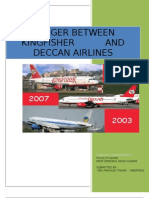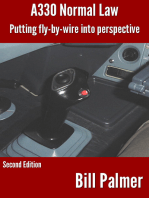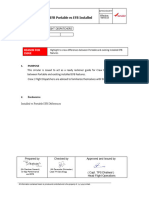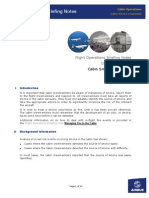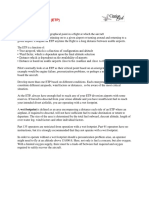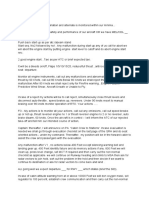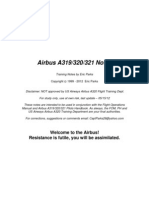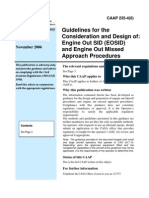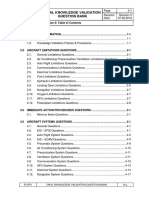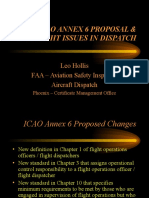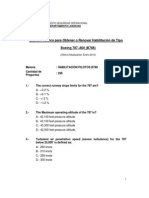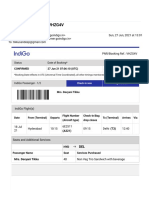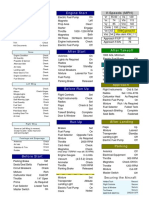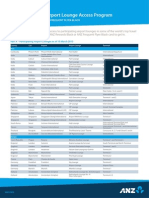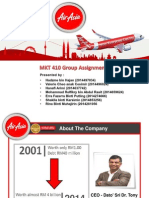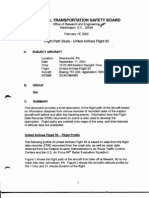Ice and Rain Protection
Ice and Rain Protection
Uploaded by
Jefferson CuCopyright:
Available Formats
Ice and Rain Protection
Ice and Rain Protection
Uploaded by
Jefferson CuCopyright
Available Formats
Share this document
Did you find this document useful?
Is this content inappropriate?
Copyright:
Available Formats
Ice and Rain Protection
Ice and Rain Protection
Uploaded by
Jefferson CuCopyright:
Available Formats
Ref: C-OL-AC4014
A320 CBT
Page: 1/10
ICE AND RAIN Rev: 1
PROTECTION Date: 01.01.2018
TABLE OF CONTENT
LEGAL CAUTION ................................................................................................................................................................. 2
ICE AND RAIN PROTECTION ............................................................................................................................................. 2
INTRODUCTION ................................................................................................................................................................... 2
ICING DETECTION............................................................................................................................................................... 3
ENGINE ANTI-ICE SYSTEM ................................................................................................................................................. 3
WING ANTI-ICE SYSTEM ..................................................................................................................................................... 4
WINDOW HEATING SYSTEM............................................................................................................................................... 6
PROBE HEATING SYSTEM ................................................................................................................................................... 7
WATER WASTE DRAIN MAST HEATING ............................................................................................................................. 8
RAIN REMOVAL ................................................................................................................................................................... 9
ANTI-ICE CONTROLS AND INDICATIONS REVIEW ......................................................................................................... 9
Copyrights © 2007 by Flyco Training Solutions
Ref: C-OL-AC4014
A320 CBT
Page: 2/10
ICE AND RAIN Rev: 1
PROTECTION Date: 01.01.2018
1
LEGAL CAUTION
The material contained in this training program is based on the information obtained from
current national, international and company regulations and it is to be used for training
purposes only. At the time of designing this program contained then current information.
In the event of conflict between data provided herein and that in publications issued by
the authority, the authority shall take precedence.
2
ICE AND RAIN PROTECTION
This chapter introduces you to the aircraft ice and rain protection system and provides
an overview of its organization, operation, control and indication. Here is the chapter
outline:
Introduction
Ice Detection
Engine Anti-ice System
Wing Anti-ice System
Window Heating System
Probe Heating system
Waste water drain mast heating
Rain Removal System
Anti-ice Controls and Indications Review
3
INTRODUCTION
When an aircraft operates in rain, for instance during takeoff or approach, the visibility
for the pilots is reduced. When the aircraft flies in icing conditions, you can imagine that
more problems are possible. The ice build-up on the aircraft results in a decrease in lift,
increase in drag and the aircraft weight increases. Engines can also have problems. Ice
can block probes for air data system. In addition ice on the windshield reduces visibility
more than rain. The purpose of the ice and rain protection system is to protect the aircraft
against those negative effects of ice and rain.
4
In flight, icing conditions exist when total air temperature is 10 °C or below and visible
moisture is present. Visible moisture is clouds, fog with visibility of one mile or less; or rain,
snow, sleet or ice crystals.
5
Icing conditions also exist on the ground when the outside air temperature is 10°C or
below and standing water, slush, ice or snow is present on the ramps, taxiways or runways.
6
There are two types of ice protection systems: an anti-icing system which prevents ice
formation by operating continuously and a de-icing system which removes the ice after
it has formed by operating intermittently. On aircraft with jet engines anti-icing systems
are used.
Copyrights © 2007 by Flyco Training Solutions
Ref: C-OL-AC4014
A320 CBT
Page: 3/10
ICE AND RAIN Rev: 1
PROTECTION Date: 01.01.2018
7
Anti-icing systems use two methods for protecting critical surfaces of the aircraft from ice
accretion: hot air heating or electrical heating. Hot air systems are referred to as thermal
anti-icing systems and electrical heating systems are referred to as electric anti-icing
systems.
8
The Airbus 320 incorporates both hot air anti-icing systems and electric anti-icing systems.
Hot air is used for engine anti-icing and wing anti-icing . Electrical heating is used to
protect flight deck windows, air data probes and waste water drain masts against icing.
9
ICING DETECTION
The task of the ice detector is to provide the pilots with visual cue when flying in icing
conditions.
10
On the Airbus 320, a visual ice indicator with integrated light is installed between the two
windshields, where it is in sight of two pilots. When the pilots see ice on the detector, there
is probably ice on the other parts of aircraft. Therefore, pilots must switch on the thermal
anti-ice systems.
11
ENGINE ANTI-ICE SYSTEM
The engine anti-ice system protects engine cowl inlet from icing. Ice on the engine cowl
inlet has two important negative effects. First, it disturbs the airflow which reduces engine
performance and may lead to a compressor stall. Second, particles of ice can be sucked
into the engine which causes damage of fan blades and inlet vanes.
12
The engine anti-ice system uses hot bleed air from corresponding engine to protect each
engine nacelle from ice. The hot air is obtained from the high pressure compressor of
each engine through a port which is independent of the pneumatic system ducting. The
engine anti-ice valves are electrically controlled and pressure operated. They connect
the cowl inlet ducts to engine bleed air. When a valve opens hot bleed air goes to the
cowl inlets and heats up the nacelle preventing ice build-up. The air is then vented
overboard.
13
The operation of the engine anti-ice system is controlled via the ENGINE ANTI-ICE switches
on the Anti-ice panel located on the forward overhead panel.
14
Individual anti-ice push-button switches for each engine let you control the position of
the respective engine anti-ice valve.
15
Engine anti-icing can be used both on the ground and inflight provided that the engines
are running. Do not rely on visual indications of airframe icing to turn the engine anti-ice
on. Engine anti-ice must be immediately activated when icing conditions specified
previously exist or are anticipated. Late activation of engine anti-ice may cause ice
buildup on the air intakes, which may result in engine damage due to ingested ice plates.
Copyrights © 2007 by Flyco Training Solutions
Ref: C-OL-AC4014
A320 CBT
Page: 4/10
ICE AND RAIN Rev: 1
PROTECTION Date: 01.01.2018
16
When icing conditions exist, or are anticipated, you must set the engine anti-ice ON
during all ground and flight operations, except during climb and cruise when the static
air temperature is less than -40 °C. Engine anti-ice must be ON before and during a
descent in icing conditions, even if the static air temperature is less than -40 °C.
17
Anti-ice should be ON, when descending even if the temperature is below -40 °C, if
known or suspected icing conditions could be encountered, before or during the
descent. An amber FAULT light illuminates momentarily in the switch when the valve is in
transit, then extinguishes. Ensure that the ENGINE ANTI-ICE message in green appears on
the ECAM memo display. With the engine anti-ice switch ON, the bleed air pressure from
the engine opens the engine anti-ice valve, which lets the hot air flow to the engine cowl
lips.
18
When either engine anti-ice valve is open, these occur automatically: the maximum N1
limit is reduced, if necessary, the idle N1 is increased for both engines in order to provide
the required pressure and the engine igniters operate continuously.
19
When engine anti-ice is no longer needed, push the engine anti-ice switch OFF. Engine
anti-ice valve closes stopping the hot bleed air flow to the cowl inlet.
20
Do not use engine anti ice on the ground and inflight when outside air temperature and
total air temperature respectively is above 10°C.
21
With the engine anti-ice switch selected ON and if the related engine anti-ice valve fails
to open, the FAULT light remains illuminated in the switch, ENGINE VALVE CLOSED caution
message with affected engine number appears on the ECAM and a single chime sounds.
In addition, master caution light illuminates on the glareshield.
22
Similarly, with the engine anti-ice switch selected OFF, if the related engine anti-ice valve
fails to close, FAULT light stays illuminated in the switch, ENGINE VALVE OPEN caution
message with affected engine number appears on the ECAM and a single chime sounds
and a master caution light illuminates on the glareshield.
23
Note that when the engine is not running, the related engine anti-ice valve automatically
closes. On the other hand, in the event of electrical power loss, the engine anti-ice valves
open.
24
WING ANTI-ICE SYSTEM
The wing anti-ice system protects the three outboard leading edge slats on each wing
from icing in flight.
25
The wing anti-ice system uses hot air from pneumatic system to provide ice protection.
The wing anti-ice control valves connect the wing distribution ducts to pneumatic system.
Copyrights © 2007 by Flyco Training Solutions
Ref: C-OL-AC4014
A320 CBT
Page: 5/10
ICE AND RAIN Rev: 1
PROTECTION Date: 01.01.2018
When the valves open hot bleed air enters distribution ducts and sprays through holes
into outboard leading edge slats. This heats up the leading edge area and prevents ice
buildup. The bleed air is then exhausted outboard through openings in lower part of
structure. The system uses telescoping ducts which makes the wing anti-icing effective
with the slats in any position.
26
Operation of the wing anti-ice system is controlled via WING ANTI-ICE switch on the Anti-
ice panel.
27
A single pushbutton switch is provided to control wing anti-ice at two sides at the same
time, because both sides must always operate symmetrically.
28
The wing anti-icing is normally operated in flight whenever icing conditions exist or are
anticipated.
29
You should set the wing anti-ice ON, whenever there is an indication that airframe icing
exists. The ice accumulation on visual ice indicator or on the windshield wipers can be
evidence of airframe icing.
30
Do not operate wing anti-ice in flight when the total air temperature is above 10°C.
31
You should avoid extended operation in icing conditions when the leading edge slats
are extended.
32
When wing anti-ice is needed, select wing anti-ice switch to ON position. Amber FAULT
light illuminates momentarily in the switch when the valves are in transit, then extinguishes.
Ensure that WING ANTI-ICE message in green appears on the ECAM memo display. With
the wing anti-ice switch ON, the air pressure from the pneumatic manifold opens the
wing anti-ice valves, which lets the hot air flow to the outboard leading edge slats.
33
With the wing anti-ice switch ON, the position and control indicating of the wing anti-ice
valve anti-ice indication is displayed on the ECAM BLEED page.
34
When the wing anti-ice valve is open, the following occur automatically: the maximum
N1 limit is reduced and the idle N1 is increased.
35
When the wing anti-ice switch is selected ON, if either or both wing anti-ice valves fail to
open, a FAULT light remains illuminated in the switch, SYSTEM FAULT caution message
appears on the ECAM and a single chime sounds. In addition, the master caution light
illuminates on the glare shield
36
If high air pressure is detected when the wing anti-ice is selected ON, a HIGH PRESSURE
caution message appears on the ECAM upper display.
Copyrights © 2007 by Flyco Training Solutions
Ref: C-OL-AC4014
A320 CBT
Page: 6/10
ICE AND RAIN Rev: 1
PROTECTION Date: 01.01.2018
37
When wing anti-ice is no longer needed, push the wing anti-ice switch OFF. The ON light
extinguishes and wing anti-ice valves close stopping the hot air flow to the outboard
leading edge slats.
38
Note that in the event of electrical power loss or if a leak is detected during normal
operation, the wing anti-ice valves close automatically
39
When the wing anti-ice switch is selected OFF, if either or both wing anti-ice valves fail to
close, a FAULT light remains illuminated in the switch, VALVE OPEN caution message
appears on the ECAM and a single chime sounds. In addition, the master caution light
illuminates on the glare shield
40
In flight the wing anti-ice system can be used intermittently as a de-icer to remove an ice
accumulation from the leading edge slats or it can be used continuously for anti-icing to
prevent any ice formation on the leading edge slats.
41
When the aircraft lands, the wing anti-ice valves close automatically without needing to
switch the wing anti ice pushbutton to OFF. The blue ON light stays illuminated as long as
the pushbutton is pressed.
42
On the ground, the wing anti-ice valves are inhibited from opening, except for testing.
When the wing anti-ice is switched to ON, the valves open for 30 seconds only to let the
flight crew check the correct operation of the system before flight.
43
If the valves stay open more than 35 seconds after wing anti-ice is switched ON while on
the ground, a WING A. ICE OPEN ON GND caution message appears on the ECAM upper
display and a single chime sounds. The master caution light illuminates on the glareshield
44
WINDOW HEATING SYSTEM
The Flight deck has 3 windows at the left and 3 windows at the right. Number 1 windows,
or the windshields, are electrically heated to prevent icing and fogging. The heating
element is a transparent, conductive film which is located behind the outer glass panel.
45
The Number 2 and 3 side windows are electrically heated to prevent fogging only.
Therefore, heating film is located near the inner glass panel.
46
Window heating activates automatically when at least one engine is started, or when
the aircraft is in the flight.
47
You can also activate window heating manually, before engine start, with the
PROBE/WINDOW HEAT switch on the Anti-ice panel.
Copyrights © 2007 by Flyco Training Solutions
Ref: C-OL-AC4014
A320 CBT
Page: 7/10
ICE AND RAIN Rev: 1
PROTECTION Date: 01.01.2018
48
Windows heating is controlled by independent window heat computers, one on each
side. The computers receive input signal from temperature sensors in windows.
49
The window heat computers maintain windows at the correct temperature. This not only
provides maximum protection against icing and/or fogging, but also ensures the highest
impact resistance of the windshields in case of a bird strike.
50
The window heat computers also provide protection against overheating and indicate
system faults.
51
When either windshield heating fails, the LEFT or RIGHT WINDSHIELD caution message
appears on the ECAM upper display, a single chime sounds and a master caution light
illuminates on the glareshield
52
Failure of both windshields heating causes the LEFT plus RIGHT WINDSHIELD caution
message to appear on the ECAM upper display, a single chime sounds and a master
caution light illuminates on the glareshield
53
When there is a failure in the side window heating, LEFT or RIGHT WINDOW caution
message appears on the ECAM upper display.
54
PROBE HEATING SYSTEM
A very important anti-ice system for flight safety is the air data probe heating. Therefore
pitot probes, static ports, angle of attack (AOA) probes and total air temperature (TAT)
probes are electrically heated against icing.
55
Three independent Probe Heat Computers (PHCs) automatically control and monitor the
captain probes, first officer probes and standby probes. The computers provide
protection against overheating and allow system faults to be indicated on the ECAM.
56
The probes are automatically heated. When you start one of the engines, the electrical
power is applied to the pitot probes, static ports and angle of attack probes for heating
against icing.
57
Pitot probe heating operates at low power on the ground and automatically switches to
normal power in flight.
58
The total air temperature probes are not heated on the ground. The probe heating is
activated automatically for icing protection when the aircraft is in flight.
Copyrights © 2007 by Flyco Training Solutions
Ref: C-OL-AC4014
A320 CBT
Page: 8/10
ICE AND RAIN Rev: 1
PROTECTION Date: 01.01.2018
59
Probe heating can also be switched on manually from the anti-ice panel by selecting
the PROBE/WINDOW HEAT switch to the ON position. This may be required when there is
a failure in the automatic circuit or for ground test.
60
When the captain static port heating fails, the CAPTAIN STATIC caution message with the
affected side label appears on the ECAM upper display, a single chime sounds and the
master caution light illuminates on the glareshield.
61
Failure of any other probe causes a similar caution message for the associated probe to
appear on the ECAM. Those messages are: F/O LEFT/RIGHT STATIC, CAPTAIN PITOT, F/O
PITOT, CAPTAIN TAT, F/O TAT, CAPTAIN AOA, F/O AOA, STANDBY LEFT/RIGHT STATIC,
STANDBY PITOT and STANDBY AOA
62
When there is double pitot probe heating failure, the following messages are displayed:
CAPTAIN + F/O PITOT, CAPTAIN+ STANDBY PITOT, or F/O + STANDBY PITOT caution message
appears on the ECAM upper display, a single chime sounds and the master caution light
illuminates on the glareshield.
63
Loss of all three pitot probes heating causes ALL PITOT caution message to appear on
the ECAM upper display. A single chime sounds and master caution light illuminates on
the glareshield.
64
When a probe heat computer fails, PROBES caution message with affected system label
appears on the ECAM upper display and a single chime sounds. Master caution light
illuminates on the glareshield.
65
You should avoid icing conditions, when there is a failure in heating of any air data probe.
66
Flying in icing conditions with a failed pitot probe, static port or angle of attack probe
heating can cause ice to accumulate on the probe, which may result in erroneous flight
instrument indications.
67
Similarly, flying in icing conditions with failed total air temperature probe heating can
cause ice to accumulate on the probe, which may result in erroneous performance
calculations.
68
In the event of double AOA heat failure, if the icing conditions cannot be avoided, turn
off one of the affected Air Data References.
69
WATER WASTE DRAIN MAST HEATING
The water waste drain masts are also electrically heated, whenever the electrical system
is powered.
Copyrights © 2007 by Flyco Training Solutions
Ref: C-OL-AC4014
A320 CBT
Page: 9/10
ICE AND RAIN Rev: 1
PROTECTION Date: 01.01.2018
70
RAIN REMOVAL
The aircraft windshields are fitted with rain removal system to improve the visibility for pilots
in rain. The rain removal system incorporates windshield wipers and rain repellent liquid
system. However, the rain repellent system is deactivated.
71
Each pilot independently controls his or her own windshield wiper with corresponding
selector on the overhead panel.
72
The windshield wiper selectors allow for speed selection and stow the wiper blades. Two
different speeds can be selected. Fast speed is used in heavy rain. Slow speed is
selected during normal rain or during taxi on the ground. When the OFF position is
selected, the wiper motor turns off and blades move to park position.
73
Note that operating windshield wipers on a dry windshield will cause windshield
scratching.
74
Rain repellent pushbuttons do not function, since the system is deactivated.
75
The rain repellent bottle, if installed, is located on the left hand side, in the rear part of
the cockpit.
76
ANTI-ICE CONTROLS AND INDICATIONS REVIEW
ENGINE ANTI-ICE switches: When selected on: Blue ON light illuminates, ENGINE ANTI-
ICE message in green appears on the ECAM memo display and the respective engine
anti-ice valve opens if bleed air is available from the engine. When selected off: ON
light extinguishes and the related engine anti-ice valve closes. FAULT light illuminates
when position of anti-ice valve disagrees with switch selection or the related valve is in
transit.
77
WING ANTI-ICE switch controls the wing anti ice system on the left and right sides
simultaneously. With the switch selected on: Blue ON light illuminates, WING ANTI-ICE
message in green appears on the ECAM memo display and both wing anti-ice valves
open if pneumatic pressure is available. On the ground, the valves open 30 seconds only
to allow system test. When selected off: ON light extinguishes and the wing anti-ice
valves close. FAULT light illuminates when either or both valves fail to achieve selected
position or low pressure is detected or the valves are in transit.
78
PROBE/WINDOW HEAT switch: AUTO : Provides automatic heating of probes in flight or
on the ground, except TAT probes, if one engine is running. When pushed on: Blue ON
light illuminates, and probes and windows are heated permanently.
Copyrights © 2007 by Flyco Training Solutions
Ref: C-OL-AC4014
A320 CBT
Page: 10/10
ICE AND RAIN Rev: 1
PROTECTION Date: 01.01.2018
79
The windshield WIPER selector has three positions: OFF: Respective wiper is parked out
of view at the base of the window. FAST: Respective wiper operates at high speed.
SLOW: Respective wiper operates at low speed. RAIN REPELLENT switch is deactivated.
80
End of course
Copyrights © 2007 by Flyco Training Solutions
You might also like
- SWISS Aviation TR IFR RadionavigationDocument290 pagesSWISS Aviation TR IFR RadionavigationKrisztián KovácsNo ratings yet
- Airbus A319320 Upgrade Preparation Book by Captain Faraz Sheikh 3Document1 pageAirbus A319320 Upgrade Preparation Book by Captain Faraz Sheikh 3Seddik YahyaouiNo ratings yet
- SLF Discussion Item NotesDocument67 pagesSLF Discussion Item Notesvidur bangiaNo ratings yet
- Merger of Kingfisher and Air Deccan IntrDocument19 pagesMerger of Kingfisher and Air Deccan IntrVed Prakash Tiwari100% (1)
- BOOK JAPPESEN - Aircraft - Inspection.and - Maintenance.recordsDocument88 pagesBOOK JAPPESEN - Aircraft - Inspection.and - Maintenance.recordsWilliam Palma100% (2)
- A320 TKE by ATA 2Document62 pagesA320 TKE by ATA 2Jefferson CuNo ratings yet
- AN A320F-32-241221-01 - Parking Brake System MalfunctionDocument10 pagesAN A320F-32-241221-01 - Parking Brake System MalfunctionThuận Nguyễn HữuNo ratings yet
- A320 PDP UpdateDocument15 pagesA320 PDP UpdateLohrasp Suraliwala100% (1)
- MB A32F Ground Speed Mini - BulletinDocument7 pagesMB A32F Ground Speed Mini - BulletinMarcos Braga100% (1)
- Picus Checklist: Pre-Flight BreifingDocument4 pagesPicus Checklist: Pre-Flight Breifingesper11111No ratings yet
- Smoke ProcedureDocument16 pagesSmoke ProcedureNejmeddine HalfaouiNo ratings yet
- Steady Aircraft Flight and PerformanceFrom EverandSteady Aircraft Flight and PerformanceRating: 5 out of 5 stars5/5 (2)
- Study Guide - Air NavDocument298 pagesStudy Guide - Air NavIvan ReyesNo ratings yet
- Project On Baggage Handling and AcceptanceDocument52 pagesProject On Baggage Handling and AcceptanceKiran Reddy50% (2)
- Aviation Weather: FAA Advisory Circular (AC) 00-6B (Blackridge Press FAA Series)From EverandAviation Weather: FAA Advisory Circular (AC) 00-6B (Blackridge Press FAA Series)No ratings yet
- A330 Normal Law: Putting Fly-by-Wire Into PerspectiveFrom EverandA330 Normal Law: Putting Fly-by-Wire Into PerspectiveRating: 5 out of 5 stars5/5 (2)
- A320 CBT Navigation: Table of ContentDocument40 pagesA320 CBT Navigation: Table of ContentAman VermaNo ratings yet
- A320 BrakesDocument22 pagesA320 BrakesVincent RadityaNo ratings yet
- Smoke ProcedureDocument25 pagesSmoke ProceduretheimbachNo ratings yet
- A320 Memory ItemsDocument9 pagesA320 Memory ItemsThabit Al AwaidyNo ratings yet
- AP UpsetRecovery BookDocument443 pagesAP UpsetRecovery BookAnonymous H9JbBB5RbRNo ratings yet
- AIRBUS A319/320/321: Sample Oral QuestionsDocument21 pagesAIRBUS A319/320/321: Sample Oral QuestionsnodynarenNo ratings yet
- B777 Portable EFB Differences CircularDocument11 pagesB777 Portable EFB Differences Circulark.vinoth.itNo ratings yet
- Cold Weather Inspection - Q400Document11 pagesCold Weather Inspection - Q400sharma33No ratings yet
- A320 Abnormal Notes PDFDocument106 pagesA320 Abnormal Notes PDFcaptmon351No ratings yet
- Cabin Smoke AwarenessDocument10 pagesCabin Smoke AwarenessEmmanuel Adell100% (1)
- A320 Memory ItemsDocument9 pagesA320 Memory ItemsTomas HezNo ratings yet
- A320 A330 A340 OEB45 BlockedAOAprobes1Document21 pagesA320 A330 A340 OEB45 BlockedAOAprobes1barrigonc33273042100% (1)
- Perf CalcDocument7 pagesPerf CalcDevdatt SondeNo ratings yet
- Airbus A320 Family Non-Normal Notes PDFDocument112 pagesAirbus A320 Family Non-Normal Notes PDFCapt Devdatt SondeNo ratings yet
- Cate, A, B, C, DDocument6 pagesCate, A, B, C, DPIYUSHNo ratings yet
- Content FCTP A320Document2 pagesContent FCTP A320Gaurav Sabharwal25% (4)
- Low Vis ProceduresDocument20 pagesLow Vis ProceduresViktor GeNo ratings yet
- Equal Time Point (ETP)Document2 pagesEqual Time Point (ETP)gambit_zetaNo ratings yet
- Nat HLA 10.05.19Document4 pagesNat HLA 10.05.19pascalNo ratings yet
- Contingency Procedures NAT RegionDocument4 pagesContingency Procedures NAT RegionflyspannerrNo ratings yet
- A320-A330-A340-A350-A380 Checklist Risk AnalysisDocument22 pagesA320-A330-A340-A350-A380 Checklist Risk Analysisfantabaires86No ratings yet
- Training Aid PDFDocument52 pagesTraining Aid PDFGirish Sreeneebus50% (2)
- Takeoff Briefing ALT 737NGDocument2 pagesTakeoff Briefing ALT 737NGRAJESHKANNAN KM100% (1)
- Unreliable AirspeedDocument10 pagesUnreliable AirspeedSajneesh SharmaNo ratings yet
- Getting Hands-On Experience With Aerodynamic DeteriorationsDocument172 pagesGetting Hands-On Experience With Aerodynamic DeteriorationsAliNo ratings yet
- AIRLINE COMMAND 25-02-2010 With PagenumbersDocument322 pagesAIRLINE COMMAND 25-02-2010 With Pagenumberstin2808No ratings yet
- 18pos06 Tailwind OperationsDocument6 pages18pos06 Tailwind OperationsSergio RomeroNo ratings yet
- Flysmart+ For Ipad Avionics Connectivity: User Guide - RevbDocument15 pagesFlysmart+ For Ipad Avionics Connectivity: User Guide - RevbHung NguyenNo ratings yet
- 2019 A320 RefuelProcedureGuidelines - V2Document2 pages2019 A320 RefuelProcedureGuidelines - V2br213No ratings yet
- P3-Chapter 6 Special Procedures Ok-R5Document26 pagesP3-Chapter 6 Special Procedures Ok-R5ali4957270No ratings yet
- Ac 00-54 Pilot Windshear Guide PDFDocument64 pagesAc 00-54 Pilot Windshear Guide PDFSantiago HidalgoNo ratings yet
- 22년 전반기sim 구술Document10 pages22년 전반기sim 구술JuKyung ParkNo ratings yet
- 20-21 Icn De-Icing Anti-Icing Pilot Brief SheetDocument12 pages20-21 Icn De-Icing Anti-Icing Pilot Brief SheetMichael Parkanski100% (1)
- Airbus NotesDocument130 pagesAirbus Notespresencia62No ratings yet
- Content FCTP A320Document2 pagesContent FCTP A320Lohrasp Suraliwala0% (1)
- CASA CAAP - EOSID and Missed Approach PerformanceDocument46 pagesCASA CAAP - EOSID and Missed Approach PerformancePeter Christophersen100% (1)
- Knowledge Validation Question Bank (R3) PDFDocument58 pagesKnowledge Validation Question Bank (R3) PDFM DarwishNo ratings yet
- A320 Technical NotesDocument118 pagesA320 Technical NotesMiran Mir0% (1)
- ABF Pilot Training Manual: Meteorology (MET)Document22 pagesABF Pilot Training Manual: Meteorology (MET)Sanjay JayaratneNo ratings yet
- The FAA ICAO Annex 6 Proposal and Oversight Issues in DispatchDocument19 pagesThe FAA ICAO Annex 6 Proposal and Oversight Issues in Dispatchmyrddin55No ratings yet
- Examen Teórico para Obtener o Renovar Habilitación de Tipo Boeing 787-800 (B788)Document72 pagesExamen Teórico para Obtener o Renovar Habilitación de Tipo Boeing 787-800 (B788)Alex E. MoralesNo ratings yet
- A320 Fuel ImbalanceDocument4 pagesA320 Fuel ImbalanceMustafa Direk100% (1)
- Specific To The Airbus - The Hidden Memory Items - Airbus Upgrade Technical SiteDocument1 pageSpecific To The Airbus - The Hidden Memory Items - Airbus Upgrade Technical SitevitorpeladoNo ratings yet
- A320-Takeoff-Performance 2Document6 pagesA320-Takeoff-Performance 2HENIGUEDRINo ratings yet
- FAR-FC 2019: Federal Aviation Regulations for Flight CrewFrom EverandFAR-FC 2019: Federal Aviation Regulations for Flight CrewNo ratings yet
- EFIS - Navigation DisplayDocument8 pagesEFIS - Navigation DisplayJefferson CuNo ratings yet
- FMS TakeoffDocument4 pagesFMS TakeoffJefferson CuNo ratings yet
- Flight ControlsDocument34 pagesFlight ControlsJefferson CuNo ratings yet
- Clock and Recording SystemsDocument6 pagesClock and Recording SystemsJefferson CuNo ratings yet
- Power Plant (CFM56)Document21 pagesPower Plant (CFM56)Jefferson CuNo ratings yet
- Fire ProtectionDocument12 pagesFire ProtectionJefferson CuNo ratings yet
- Flight AugmentationDocument4 pagesFlight AugmentationJefferson CuNo ratings yet
- Cae A320 Fcom FullDocument3,500 pagesCae A320 Fcom FullJefferson CuNo ratings yet
- De IcingDocument11 pagesDe IcingJefferson CuNo ratings yet
- AIP Cabo VerdeDocument2 pagesAIP Cabo VerdeLestatGeb0% (1)
- Airbus A320Document22 pagesAirbus A320T.h. Min0% (1)
- NF22995136307762 InvoiceDocument3 pagesNF22995136307762 InvoiceMonalisa NandaNo ratings yet
- Gmail - Your IndiGo Itinerary - VHZG4VDocument5 pagesGmail - Your IndiGo Itinerary - VHZG4VVohimelNo ratings yet
- Check list-PA-28-140 (2015)Document2 pagesCheck list-PA-28-140 (2015)ПетрNo ratings yet
- Economic Growth of Airlines Industry: An Overview of Domestic Airlines in BangladeshDocument9 pagesEconomic Growth of Airlines Industry: An Overview of Domestic Airlines in BangladeshtasnufaNo ratings yet
- World Air Forces 2010Document32 pagesWorld Air Forces 2010Jason Coley100% (1)
- Holding ApronDocument10 pagesHolding ApronJagadeeshNo ratings yet
- Landing Gear Slide Chapter 3Document35 pagesLanding Gear Slide Chapter 3mellon3duwen100% (1)
- Pengesahan - Daftar MasukDocument5 pagesPengesahan - Daftar MasukMax VNo ratings yet
- A6M2 Zero Type 21 Type 21Document20 pagesA6M2 Zero Type 21 Type 21Gerson FreireNo ratings yet
- Complimentary Airport Lounge Access Program Terms ConditionsDocument2 pagesComplimentary Airport Lounge Access Program Terms ConditionsMochammad Reza ZakariaNo ratings yet
- Air Asia Mix MarketingDocument29 pagesAir Asia Mix MarketingHadzme Hajan100% (1)
- (Model Cardboard) - Macchi C 202 Folgore (1-50)Document2 pages(Model Cardboard) - Macchi C 202 Folgore (1-50)Jang PurkonNo ratings yet
- NF2EMFBISLUEUV831494 ETicketDocument4 pagesNF2EMFBISLUEUV831494 ETicketMohd AhmadNo ratings yet
- AC43-18 CHG 1-2 Fabrication of Parts by Maintenance Personnel PDFDocument20 pagesAC43-18 CHG 1-2 Fabrication of Parts by Maintenance Personnel PDFJesseNo ratings yet
- Army Aviation Digest - Jan 1982Document52 pagesArmy Aviation Digest - Jan 1982Aviation/Space History LibraryNo ratings yet
- Wizzair Checklist 2 1Document1 pageWizzair Checklist 2 1christopherchadwick79No ratings yet
- ch650 Manual EnglishDocument21 pagesch650 Manual EnglishJustinFlierNo ratings yet
- Air Travel On Official TourDocument4 pagesAir Travel On Official TourGulshan BistNo ratings yet
- E Ticket - BOLANIO - JULY29-AUG01 PDFDocument1 pageE Ticket - BOLANIO - JULY29-AUG01 PDFRobert Adrian De RuedaNo ratings yet
- pdf-59 0Document11 pagespdf-59 0ccoyureNo ratings yet
- Foreign Technology DivisionDocument467 pagesForeign Technology DivisionArashNo ratings yet
- ItineraryDocument2 pagesItinerarypasswordvault softwareoneNo ratings yet
- T8 B15 Hijacked Airplanes 3 of 3 FDR - NTSB Reports On UA 93Document26 pagesT8 B15 Hijacked Airplanes 3 of 3 FDR - NTSB Reports On UA 939/11 Document ArchiveNo ratings yet
- اسئلة تشريعات- A1Document38 pagesاسئلة تشريعات- A1wagih83115100% (1)



